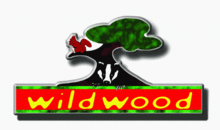Wildwood Discovery Park
 | |
| Date opened | 1999 |
|---|---|
| Location | North-east Kent, England |
| Coordinates | 51°19′52″N 1°7′9″E / 51.33111°N 1.11917°ECoordinates: 51°19′52″N 1°7′9″E / 51.33111°N 1.11917°E |
| Number of species | 50+ |
| Annual visitors | 100,000 |
| Website | www.wildwoodtrust.org |
Wildwood Discovery Park is a woodland discovery park in north-east Kent, England. It features over fifty species of native British animals such as deer, badgers, wild boar and wolves. It is located on the main road A291 between Herne Bay and Canterbury.
Wildwood is a Registered Charity in England, No 1093702, whose aim is to save British Wildlife from extinction and reintroduce recently made extinct animals such as European beaver, wild boar and Modern Tarpan (Konik).
Wildwood Trust are achieving this through operating a wildlife education project that attracts nearly 100,000 visitors each year and educating 13,000 children on organised education trips. Wildwood Trust has an active membership of about 40,000.
Visitors to the park can see British animals species past and present, with the animals set in natural enclosures.
History
Wildwood's history can be traced back to the 1970s when Terry Standford, Operations Director of English Woodlands, created a woodland nature reserve which grew into a small wildlife park in a woodland setting. This evolved into a small zoo called Brambles. Following major reinvestment from Terry Standford and his business partners Peter and David Rosling ‘Wildwood Discovery Centre’ started life in 1999 as a visitor centre, with the vision to educate local people about the need to conserve native wildlife and their habitats.
After three years of Wildwood being open the owners decided its future would be best secured by it becoming a charitable trust. A Charitable Trust was formed By Kenneth West, a retired company Chairman and Peter Smith, a conservation scientist and charity management expert and they assumed running of the park in June 2002, and officially took over the park in December of that year. Since then has been known as Wildwood Trust. The Trust has grown considerably in this time and is now one of the largest charities in Kent.
Site
A twisting trail winds through 42 acres (170,000 m2) of natural ancient woodland which is attached to the Blean, one of the largest areas of ancient woodland in southern England. The woods have been managed by humans on a coppice rotation, harvesting trees between 5–20 years, allowing the stools to regenerate. Parts of the Blean woods are a Site of Special Scientific Interest due to the presence of habitats and species of national importance. Heathy areas provides an important habitat for the rare heath fritillary butterfly Melitaea athalia, a UK BAP priority species, historically linked with traditional woodland coppicing. The caterpillar’s food plant, common cow-wheat is abundant in the woodland.
Consisting mainly of sweet chestnut, silver birch and English oak, one area of Wildwood includes a former conifer plantation of Corsican pine and Western hemlock. Some timber is used in the park, while much is left to provide suitable habitat for invertebrates and small mammals. The natural wildlife in the park includes red foxes, hazel dormice, wood and yellow-necked mice, bank and field voles, common and pygmy shrews, nightingales, woodpeckers (all three species), tawny owls, jays, tits (four species), thrushes, stag beetles, dragonflies, wood ants, bumblebees and butterflies.
Animals
The collection reflects species currently native, introduced and those previously native to Britain, back to the last ice age (~10,000 years ago). Wildwood Trust currently maintains the most varied native collection in the UK, comprising 30 mammals, 18 birds, 6 reptiles and 4 amphibians. The two highlights for visitors are the large pack of European wolves roaming a wooded enclosure, and a group of badgers in their underground set. Other species rarely kept in UK collections are water shrews, pine martens, stoats, roe deer, European beavers, coypu (the only exhibit of this species in the UK), ravens, Eurasian cranes and Northern adders.
Education
Wildwood Trust's Education team offers a range of National Curriculum-linked programmes for local schools, such as adaptation, homes and habitats through to animals in Viking myths and English folklore, as well as running an informal public education programme including talks and events. Educators and animal staff work closely together to host a variety of programmes, from animal talks to training courses.
Conservation
One species that Wildwood is indelibly linked with is the breeding of water voles. This species was in recent years tagged ‘the most catastrophically endangered species in the UK’ because of the decline linked to habitat loss and the impact of introduced mink. While previously a lot of effort went into mitigation contracts and supplying other zoos with stock, Wildwood Trust is now concentrating on reintroducing the species into new or reclaimed habitat through partnerships with other conservation organisations, including the Environment Agency, People's Trust for Endangered Species, WildCRU at Oxford University and the University of Greenwich.
Another major success has been the reintroduction of captive-bred hazel dormice, with a large number of Wildwood stock transferred to sites in the Midlands and Yorkshire. Other on-going projects include DNA and behavioural research on pine martens with Waterford Institute of Technology in Éire; funding for the pool frog reintroduction with [[Herpetological Conservation Trust]]/English Nature; water shrew husbandry with Imperial College, London; and in-situ breeding of harvest mice with Chester Zoo.
Future projects will see Wildwood being more involved the utilisation of large herbivores for near-natural grazing.
Two species (European beavers and konik polski) are currently used for these purposes on several reserves in Kent. Konik polski (meaning ‘Polish small horses’) are a robust breed closely related to the extinct tarpan and have been used in similar grazing schemes in the Netherlands and Poland. The long-term vision is for Wildwood Trust to manage large tracts of land with large once-native herbivores such as koniks, beavers, wild boar, and heck cattle (re-created aurochs).
That future vision will hopefully see British people experiencing the real Wildwood again.